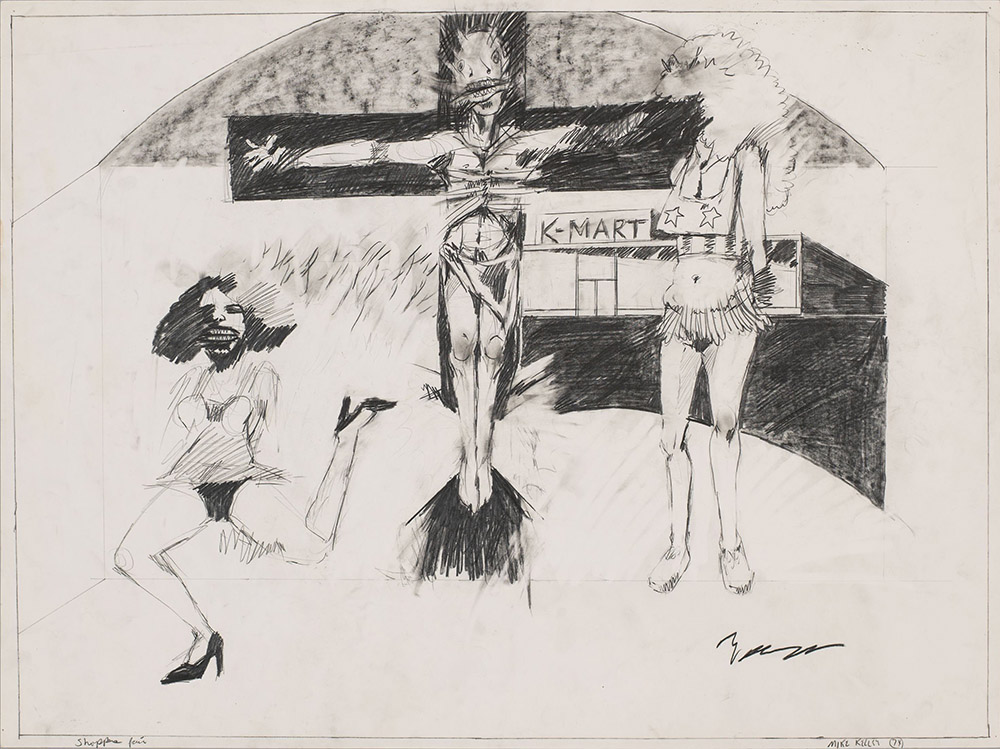ART CITIES:Zurich-Mike Kelley

Mike Kelley worked in a startling array of genres and styles, including performance, installation, drawing, painting, video, photography, sound works, text, and sculpture. He also worked on curatorial projects; collaborated with many other artists and musicians; and left a formidable body of critical and creative writing. His work questions the legitimacy of “normative” values and systems of authority, and attacks the sanctity of cultural attitudes toward family, religion, sexuality, art history, and education.
By Dimitris Lempesis
Photo: Hauser & Wirth Gallery Archive
The exhibition “God’s Oasis” provides a deeper understanding of Mike Kelley’s career by investigating the artist’s formative years in his hometown of Detroit, his subsequent work as an undergraduate student in Ann Arbor, Michigan and his reconsideration of this artistic output decades later. On presentation are rarely exhibited works on paper, including a selection of student drawings from the Mike Kelley Foundation for the Arts Archives, paintings from Kelley’s reworked “Missing Time” series (1974-94) and works from his “Untitled” series of collages (1974-2011), many of which have never been seen or exhibited before. Also on view are the installation “Rose Hobart II” (2006) and the mobile sculpture and accompanying drawing for “Repressed Spatial Relationships Rendered as Fluid #1: Martian School (Work Site)” (2002). As a response to the prevailing modernist aesthetic he encountered during the course of his instruction at the University of Michigan in Ann Arbor (1973-76), Kelley often appropriated imagery from low-end vernacular, and counterculture, taking inspiration from local comic books and artists, erotica, pulp fiction and advertising. Series like Kelley’s cartoon-based works “Untitled (Allegorical Drawings)” (1976) abound with loaded representations of contemporary American culture. Kelley grew up during a time in which Detroit was facing severe crises caused by rapid deindustrialization, the civil rights movement, and economic downturn. This environment lead him to embrace the anarchist counterculture. Kelley became a participant in both White Panther Party and the underground punk music scene. In 1974, while attending the University of Michigan, he co-founded the proto-punk, experimental noise band Destroy All Monsters (DAM). The member of the band were: Mike Kelley on drums and vocals, Jim Shaw on vocals and squeeze toys, Niagara (Lynn Rovner) on vocals, and Cary Loren on guitar and vocals. On New Year’s Eve of 1973, the first DAM concert was held at a comic book convention in Ann Arbor. They performed a demented version of Black Sabbath’s “Iron Man” and were asked to leave after ten minutes. The group used modified instruments, a drum box, tape loops, hot-wired toys, cheap keyboards and broken electronic devices. DAM convened in the basement of Kelley’s student accommodation, also known as “God’s Oasis Drive-In Church”, which soon became a communal space for the band to collaborate. A pivotal period in his artistic development, Kelley and DAM paid homage to the city of Detroit and its musical and artistic influence in “Strange Früt: Rock Apocrypha from 2000”, a suite of four large-scale mural paintings: “Mall Culture”, “The Heart of Detroit by Midnight”, Greeting from Detroit” and “Amazing Freaks of the Motor City”. The exhibition explores the backdrop of Detroit and Ann Arbor and its influence on Kelley’s career from the 1970s onwards. The artist’s re-examination of this period became inextricably linked with other themes at the forefront of his practice, such as repressed memory, education, sexuality and class. Kelley used the popularised theory of Repressed Memory Syndrome as a way of revisiting the works from his student days, a concern that lead to his seminal work “Educational Complex” (1995). By repurposing and recycling works from series such as “Missing Time” (1974-94) and the “Untitled” collages (1974-2011), Kelley aimed to disturb their historical reception and to understand the categories by which they were originally defined. Kelley’s installation “Rose Hobart II” (2006) is exemplary of his perpetual interest in re-examining the student experience. Inside a wooden structure a sequence from Bob Clark’s 1981 film “Porky’s” plays on a loop, with the soundtrack replaced by Morton Subtonik’s “The Wild Bull” (1968). Resembling a large megaphone-shaped object and the structure of one of Kelley’s early performance props “Perspectaphone” (1978), the viewer is required to crawl on all fours from either of the two tunnel entrances to view an excerpt of the film, which focuses on the infamous nude shower scene edited in slow-motion. A grotesque and comic spectacle, Kelley creates a voyeuristic experience which transports viewers back to the escapades of adolescent youth. The well-crafted object may also be viewed as a parody of the rational forms of minimalist sculpture, encapsulating the artist’s interest in resisting formal art practices and education.
Info: Curator: Peter Pakesch, Hauser & Wirth Gallery, Limmatstrasse 270, Zurich, Duration: 22/9-21/12/18, Days & Hours: Tue-Fri 11:00-18:00, Sat 11:00-17:00, www.hauserwirth.com










